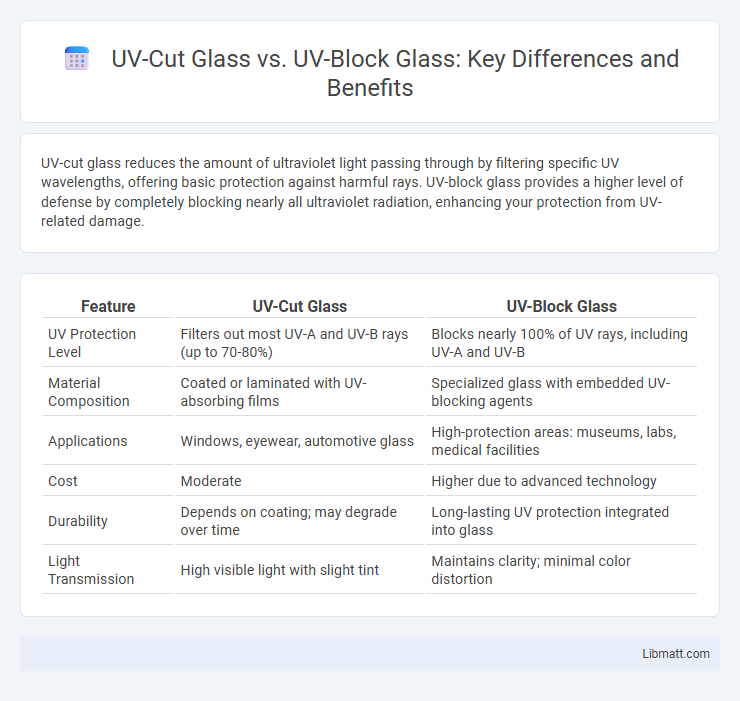UV-cut glass reduces the amount of ultraviolet light passing through by filtering specific UV wavelengths, offering basic protection against harmful rays. UV-block glass provides a higher level of defense by completely blocking nearly all ultraviolet radiation, enhancing your protection from UV-related damage.
Table of Comparison
| Feature | UV-Cut Glass | UV-Block Glass |
|---|---|---|
| UV Protection Level | Filters out most UV-A and UV-B rays (up to 70-80%) | Blocks nearly 100% of UV rays, including UV-A and UV-B |
| Material Composition | Coated or laminated with UV-absorbing films | Specialized glass with embedded UV-blocking agents |
| Applications | Windows, eyewear, automotive glass | High-protection areas: museums, labs, medical facilities |
| Cost | Moderate | Higher due to advanced technology |
| Durability | Depends on coating; may degrade over time | Long-lasting UV protection integrated into glass |
| Light Transmission | High visible light with slight tint | Maintains clarity; minimal color distortion |
Introduction to UV-Cut Glass and UV-Block Glass
UV-cut glass filters out a significant portion of ultraviolet (UV) rays, typically blocking UVB and some UVA rays to protect interiors from sun damage and fading. UV-block glass offers a higher level of UV protection by nearly eliminating both UVA and UVB penetration, providing enhanced defense against skin damage and material degradation. Both types are used in windows, eyewear, and automotive glass to improve UV protection, with UV-block glass delivering superior performance for sensitive environments.
Understanding Ultraviolet (UV) Radiation
Ultraviolet (UV) radiation consists of UVA, UVB, and UVC rays, with UVA and UVB being primary contributors to skin damage and material degradation. UV-cut glass is specifically engineered to reduce the transmission of UVA and UVB rays, offering partial protection by filtering out a significant portion of harmful radiation. UV-block glass provides a more comprehensive barrier, often integrating advanced coatings or laminations to block nearly 100% of UV radiation, ensuring enhanced protection for occupants and furnishings.
What is UV-Cut Glass?
UV-cut glass is designed to selectively filter out ultraviolet (UV) radiation, primarily blocking UV-A and UV-B rays while allowing visible light to pass through. It typically contains special coatings or additives that absorb or reflect harmful UV wavelengths, reducing potential skin damage and fading of interior materials. Compared to UV-block glass, which offers near-total UV protection, UV-cut glass provides a balanced solution for enhanced visibility and UV defense.
What is UV-Block Glass?
UV-block glass is specially engineered to filter out harmful ultraviolet (UV) rays, protecting interiors from UV-induced damage such as fading and deterioration. It typically incorporates a coating or interlayer that absorbs or reflects UV radiation, blocking up to 99% of UV-A and UV-B rays. This type of glass is commonly used in windows, skylights, and display cases to preserve furnishings and enhance occupant comfort.
Key Differences: UV-Cut Glass vs UV-Block Glass
UV-cut glass selectively filters ultraviolet rays, typically blocking up to 99% of UVA and UVB wavelengths, while maintaining visible light transmission for clarity. UV-block glass provides a stronger barrier, often incorporating additional coatings or laminates to absorb and reflect nearly 100% of UV radiation, enhancing protection for your skin and furnishings. Choosing between UV-cut and UV-block glass depends on your priority for balancing natural light with optimal UV defense in windows or eyewear.
Benefits of UV-Cut Glass
UV-cut glass effectively reduces harmful ultraviolet rays by filtering out up to 99% of UV-A and UV-B radiation, protecting interiors from UV-induced fading and deterioration. This glass enhances energy efficiency by minimizing heat gain, reducing air conditioning costs while maintaining natural light transmission. UV-cut glass contributes to skin protection and prevents damage to furniture, artwork, and fabrics, making it ideal for residential and commercial applications.
Advantages of UV-Block Glass
UV-block glass offers superior protection by filtering out nearly 100% of harmful ultraviolet rays, which prevents skin damage and fading of interior furnishings. It effectively reduces heat transmission, enhancing energy efficiency and maintaining indoor comfort. Its durability and long-lasting performance make it ideal for both residential and commercial applications focused on UV protection.
Applications in Residential and Commercial Spaces
UV-cut glass effectively reduces ultraviolet radiation transmission, protecting interior furnishings and occupants from harmful UV rays in both residential and commercial spaces. UV-block glass offers higher UV protection by completely blocking ultraviolet rays, making it ideal for museums, galleries, and medical facilities requiring stringent UV control. Both types enhance energy efficiency and comfort but differ in UV protection levels tailored to specific environmental needs.
Considerations for Choosing UV Protection Glass
When choosing UV protection glass, consider the specific level of ultraviolet radiation blocking needed for your environment and the glass's effectiveness in preventing UV damage to interiors or skin. UV-cut glass typically filters out a significant portion of UV rays while maintaining clarity and visibility, whereas UV-block glass often offers near-complete UV protection but may reduce light transmission and alter color perception. Your choice should balance UV protection performance with factors like glass transparency, durability, and intended application to ensure optimal safety and comfort.
Conclusion: Selecting the Right UV Protective Glass
UV-cut glass reduces ultraviolet rays by filtering specific UV wavelengths, offering moderate protection for your skin and interior furnishings. UV-block glass provides a higher level of defense by completely blocking nearly all UV radiation, making it ideal for sensitive environments and prolonged sun exposure. Choosing between UV-cut and UV-block glass depends on the required level of UV protection and the specific needs of your space.
UV-cut glass vs UV-block glass Infographic

 libmatt.com
libmatt.com